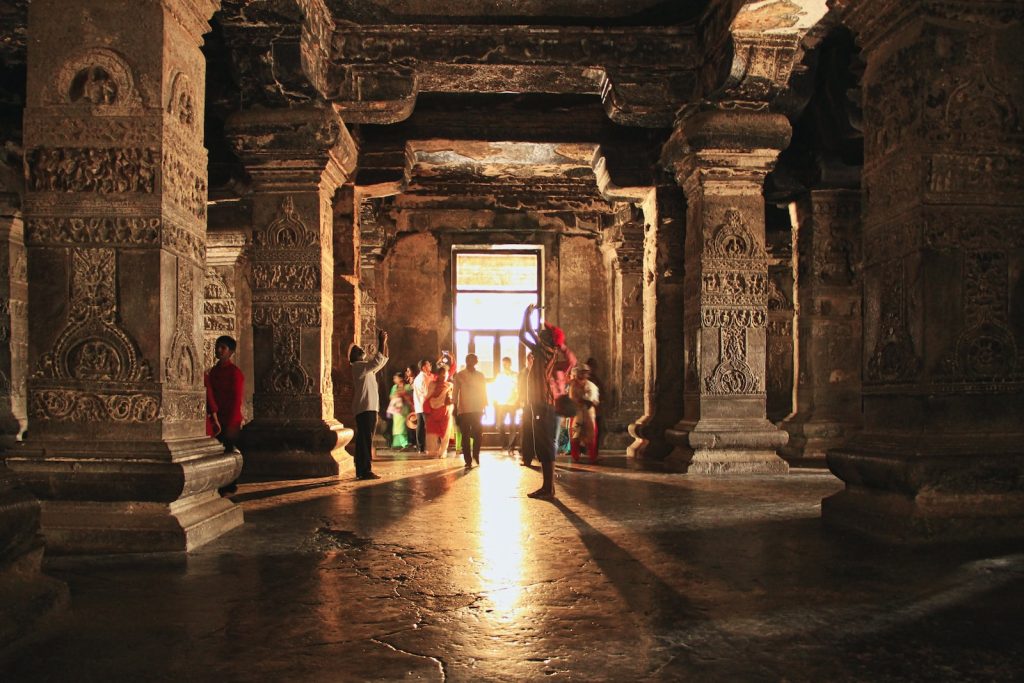Mudras are hand gestures that hold significant cultural and symbolic value in Indian traditions. They are believed to have spiritual and healing properties, and are commonly used in yoga, meditation, and dance practices. Mudras are also an integral part of Indian art and iconography, with each gesture representing a specific deity or concept.

The origins of mudras can be traced back to ancient Hindu texts such as the Vedas and the Upanishads. These texts describe the use of hand gestures in rituals and ceremonies, as well as in the practice of yoga and meditation. Over time, mudras evolved to become a complex system of hand gestures with specific meanings and purposes.
This article will explore the cultural significance and symbolism of mudras in Indian traditions. It will delve into the history and evolution of mudras, as well as their role in yoga, meditation, and dance practices. The article will also examine the various types of mudras and their meanings, and the ways in which they are used in Indian art and iconography.
Origins of Mudras in Indian Culture

Mudras have been an integral part of Indian culture for centuries, with their use dating back to ancient times. The word “mudra” is derived from the Sanskrit language, meaning “seal” or “gesture.”
In Hinduism, mudras are used during religious rituals and ceremonies to symbolize different aspects of the divine. They are also used in yoga practice to enhance physical and mental well-being.
The origins of mudras can be traced back to the ancient Indian texts known as the Vedas. These texts contain descriptions of hand gestures used during religious ceremonies, and their significance in invoking the gods.
Over time, mudras evolved to encompass a wide range of meanings and uses. They came to be associated with various deities, emotions, and physical and mental states.
Today, mudras continue to play an important role in Indian culture, with their use extending beyond religious and spiritual contexts. They are also used in dance, theater, and other forms of artistic expression.
Overall, mudras are a rich and complex aspect of Indian culture, with a long and fascinating history.
Types of Mudras and Their Meanings

Gyan Mudra
Gyan Mudra is one of the most commonly used mudras in yoga and meditation. It is formed by joining the tips of the index finger and thumb, while the other three fingers are extended. This mudra is believed to enhance concentration, memory, and wisdom. It is also associated with the element of air and the planet Jupiter.
Anjali Mudra
Anjali Mudra, also known as Namaste Mudra, is formed by bringing the palms together in front of the heart chakra. This mudra is a gesture of respect, gratitude, and reverence. It is commonly used in yoga and meditation practices as a way to connect with oneself and others. Anjali Mudra is associated with the element of ether and the planet Mercury.
Prana Mudra
Prana Mudra is formed by joining the tips of the ring finger, little finger, and thumb, while the other two fingers are extended. This mudra is believed to enhance vitality, energy, and immunity. It is also associated with the element of fire and the planet Mars.
Shuni Mudra
Shuni Mudra is formed by joining the tip of the middle finger and thumb, while the other fingers are extended. This mudra is believed to enhance patience, discipline, and focus. It is also associated with the element of earth and the planet Saturn.
Mudras are a powerful tool for connecting with oneself and the universe. By using these hand gestures in combination with breath and intention, one can tap into the deeper aspects of their being and cultivate a greater sense of balance and harmony.
Mudras in Classical Indian Dance

Mudras play a significant role in classical Indian dance forms such as Bharatanatyam, Kathak, and Manipuri. These dances are not only a form of entertainment but also a medium of spiritual expression. Mudras are used to convey emotions and tell stories through hand gestures.
In Bharatanatyam, mudras are an essential aspect of the dance form. The dancer uses mudras to depict various characters and emotions. For example, the “Hamsasya” mudra is used to depict a swan, while the “Ardha Chandra” mudra is used to depict a half-moon. The dancer’s hand movements are precise and graceful, and the mudras add a new dimension to the performance.
In Kathak, mudras are used to convey the meaning of the lyrics. The dancer uses mudras to depict various objects and emotions. For example, the “Trishul” mudra is used to depict a trident, while the “Shankha” mudra is used to depict a conch shell. The mudras are an integral part of the dance form, and the dancer’s hand movements are quick and precise.
In Manipuri, mudras are used to depict nature and animals. The dancer uses mudras to depict various birds and animals. For example, the “Kangaroo” mudra is used to depict a kangaroo, while the “Mayura” mudra is used to depict a peacock. The mudras add a new dimension to the performance and make it more expressive.
In conclusion, mudras are an essential aspect of classical Indian dance forms. They add a new dimension to the performance and make it more expressive. The hand gestures are precise and graceful, and they convey various emotions and stories.
Mudras in Yoga and Meditation

Mudras in Hatha Yoga
Hatha Yoga is a popular form of yoga that uses physical postures (asanas) and breathing techniques (pranayama) to improve physical and mental health. Mudras are an integral part of Hatha Yoga practice and are used to enhance the benefits of asanas and pranayama.
In Hatha Yoga, mudras are used to direct the flow of energy (prana) in the body. The most commonly used mudras in Hatha Yoga are:
- Gyan Mudra: This mudra is formed by touching the tip of the index finger to the tip of the thumb, while keeping the other three fingers straight. It is believed to improve concentration and memory.
- Prithvi Mudra: This mudra is formed by touching the tip of the ring finger to the tip of the thumb, while keeping the other three fingers straight. It is believed to increase strength and vitality.
- Varun Mudra: This mudra is formed by touching the tip of the little finger to the tip of the thumb, while keeping the other three fingers straight. It is believed to improve skin health and hydration.
Mudras in Kundalini Yoga
Kundalini Yoga is a spiritual practice that aims to awaken the dormant energy (kundalini) at the base of the spine and bring about spiritual enlightenment. Mudras are an important part of Kundalini Yoga practice and are used to activate and balance the energy centers (chakras) in the body.
In Kundalini Yoga, mudras are used to channel the flow of energy (prana) in the body and to focus the mind. The most commonly used mudras in Kundalini Yoga are:
- Sat Kriya: This mudra is used during the Sat Kriya exercise, which involves chanting the mantra “Sat Nam” while sitting in a kneeling position with the arms extended above the head. The mudra involves interlocking the fingers and raising the arms above the head.
- Gyan Mudra: This mudra is used during meditation to improve concentration and memory.
- Lotus Mudra: This mudra is used to activate the heart chakra and promote feelings of love and compassion. It involves placing the hands in the shape of a lotus flower in front of the heart.
The Influence of Mudras Beyond India

Buddhism and Mudras
Mudras have played a significant role in the Buddhist tradition, particularly in the Mahayana and Vajrayana schools. In Mahayana Buddhism, mudras are used to symbolize various aspects of the Buddha’s teachings and to aid in meditation. Mudras are also an integral part of the practice of Tibetan Buddhism, where they are used to represent different deities and to facilitate the visualization of complex mandalas.
One of the most well-known mudras in Buddhism is the Vitarka mudra, which is commonly used by the Buddha to symbolize teaching or discussion. This mudra is also used by many Buddhist practitioners to represent the transmission of knowledge or wisdom.
Mudras in Contemporary Wellness Practices
In recent years, mudras have gained popularity in the world of wellness and alternative medicine. Many practitioners of yoga, meditation, and other holistic practices use mudras to enhance the benefits of their practice.
One popular mudra in contemporary wellness practices is the Gyan mudra, which is believed to enhance concentration and memory. This mudra is formed by touching the tip of the index finger to the tip of the thumb, while keeping the other three fingers extended.
Another commonly used mudra is the Anjali mudra, which is formed by bringing the palms of the hands together in front of the heart. This mudra is often used as a gesture of respect and gratitude, and is commonly used in yoga classes as a way to begin and end a practice.
Overall, mudras have had a significant impact on Indian culture and traditions, and continue to be an important part of many spiritual and wellness practices around the world.
Interpreting Mudras: Symbolism and Modern Relevance

Mudras, or hand gestures, are an integral part of Indian culture and spirituality. They are used in various religious and cultural practices to convey symbolic meanings and messages. Mudras are believed to have the power to influence not only our physical well-being but also our mental and spiritual states. In this section, we will explore the symbolism of mudras and their relevance in modern times.
Symbolism of Mudras
Mudras are symbolic gestures that represent different aspects of life, emotions, and spiritual concepts. They are believed to have originated from the ancient Indian practice of yoga, where they were used to channel the flow of energy in the body. Mudras are also used in Indian classical dance forms to convey emotions and tell stories.
Each mudra has a specific meaning and is associated with a particular deity or spiritual concept. For example, the Gyan mudra, also known as the chin mudra, is associated with knowledge and wisdom. It is formed by touching the tip of the index finger to the tip of the thumb, while the other three fingers are extended. The Abhaya mudra, on the other hand, represents fearlessness and protection. It is formed by raising the right hand with the palm facing outwards.
Modern Relevance of Mudras
In modern times, mudras are still used in various forms of yoga and meditation practices. They are also used in alternative forms of healing such as acupressure and reflexology. Mudras are believed to have a calming effect on the mind and body, and can help alleviate stress and anxiety.
Moreover, mudras can be used to enhance communication and expressiveness. They are used by public speakers, actors, and musicians to convey emotions and connect with their audience. Mudras can also be used in everyday life to express oneself and communicate non-verbally.
In conclusion, mudras are an important part of Indian culture and spirituality. They have a rich symbolic meaning and are still relevant in modern times. Whether used in yoga, meditation, healing, or communication, mudras can help enhance our physical, mental, and spiritual well-being.
Dr. Harlan Kilstein is a certified yoga teacher, hypnotherapist, and a teacher of the Law of Attraction since 1975.
After an immersion in yoga and his certification by the Yoga Alliance, he began studying mudras and invented Finger Healing.

